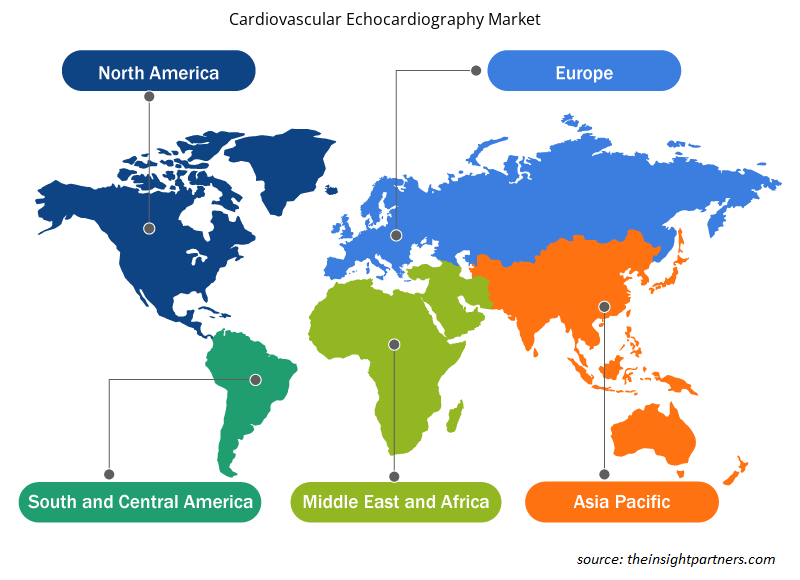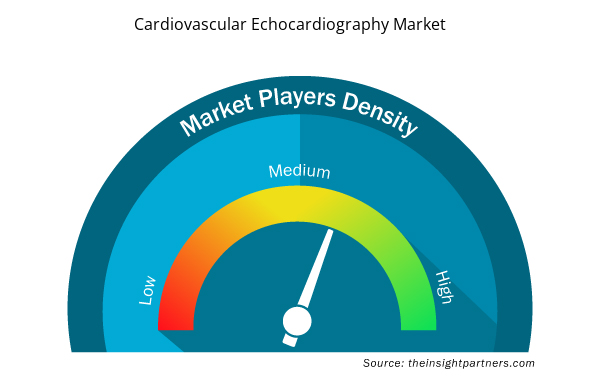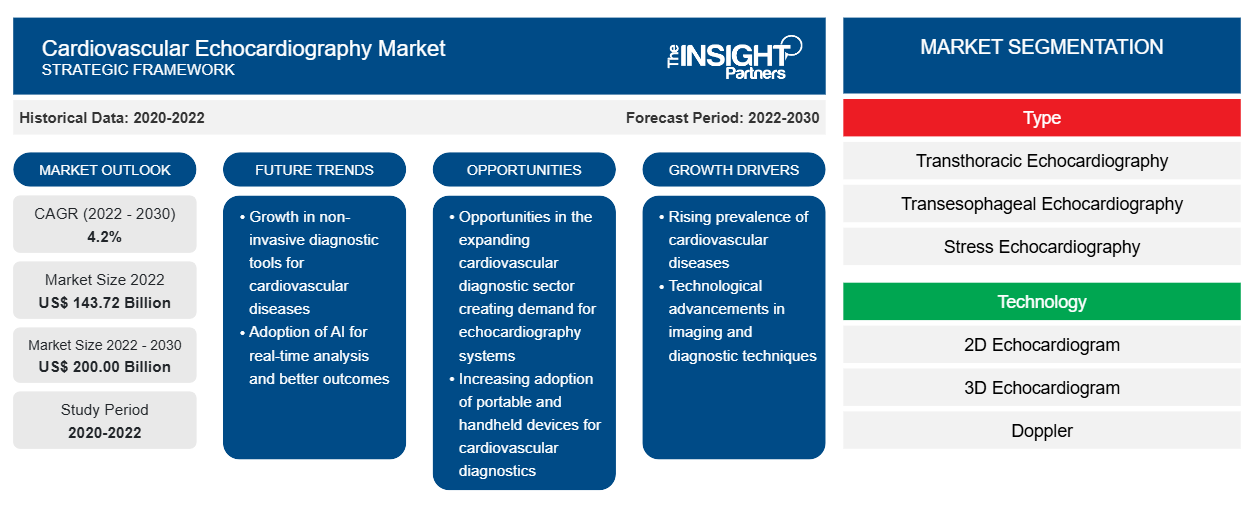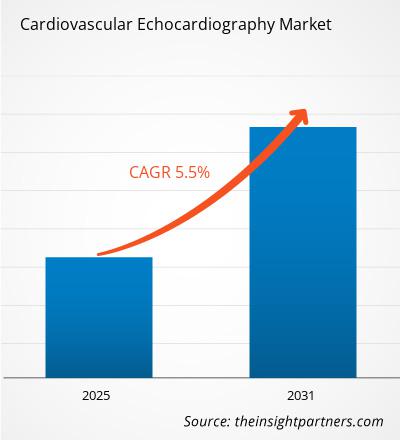[Informe de investigación] Se proyecta que el tamaño del mercado de ecocardiografía cardiovascular alcance los 200.000 millones de dólares estadounidenses para 2030 desde los 143.720 millones de dólares estadounidenses en 2022; se estima que el mercado registrará una CAGR del 4,2% durante 2022-2030.
Perspectivas del mercado y opinión de analistas:
La ecocardiografía cardiovascular es un tipo de imagen médica para examinar el corazón. Utiliza ondas sonoras para crear imágenes visuales del corazón. Este procedimiento de prueba generalmente se realiza en pacientes con enfermedades cardíacas sospechadas o conocidas. Además de revelar el tamaño y la forma de las cámaras y válvulas, la prueba también estima el funcionamiento del corazón calculando el gasto cardíaco, la fracción de eyección y la función diastólica. El ecocardiograma cardiovascular también puede detectar miocardiopatías. Las lesiones del ataque cardíaco anterior se pueden visualizar claramente mediante ecocardiógrafos. La ecografía cardíaca transtorácica, transesofágica y de estrés se encuentran entre las diversas pruebas de ecografía cardíaca que se realizan con fines de diagnóstico. Se prevé que la creciente carga de enfermedades cardiovasculares y la creciente población geriátrica creen amplias oportunidades para el crecimiento del mercado de la ecocardiografía cardiovascular .
Factores impulsores del crecimiento:
Durante el examen y la evaluación de un ataque cardíaco, dolor de pecho, enfermedad de las arterias coronarias, coágulos de sangre y otros trastornos relacionados con el corazón, los médicos recomiendan tratamientos invasivos que implican análisis de sangre y cateterismo cardíaco. El cateterismo cardíaco requiere una hospitalización prolongada y causa ciertos efectos secundarios como sangrado, coágulos de sangre, daño a las arterias y otras complicaciones. Por estas razones, los médicos generalmente limitan el uso de este procedimiento para el diagnóstico cardíaco y, en su lugar, recurren al uso de pruebas de esfuerzo cardíaco nuclear, imágenes por resonancia magnética , ecografía cardíaca y angiografía por tomografía computarizada coronaria, ya que estos procedimientos se realizan de forma no invasiva.
La ecocardiografía es la prueba de diagnóstico cardiovascular más utilizada después de la electrocardiografía y la radiografía de tórax. Es un procedimiento de diagnóstico no invasivo que revela información sobre el funcionamiento cardíaco y la hemodinámica. Debido a que los riesgos asociados a la ecocardiografía son mínimos o nulos en comparación con otros procedimientos de diagnóstico que utilizan radiación para producir resultados, se ha observado una amplia adopción de estos dispositivos en hospitales y centros de diagnóstico. Además, los pacientes con antecedentes de insuficiencia cardíaca se benefician del control rutinario con estos diagnósticos de enfermedades cardíacas. También ayuda a controlar la enfermedad y la eficacia del tratamiento o la cirugía. Las ecocardiografías también se utilizan en la atención habitual de pacientes sometidos a tratamiento contra el cáncer que corren el riesgo de sufrir cardiotoxicidad.
Las ventajas asociadas con el uso de dispositivos ecocardiográficos en comparación con otros procedimientos de diagnóstico cardíaco impulsan su adopción, impulsando así el crecimiento del mercado de la ecocardiografía cardiovascular.
Las tendencias del mercado de la ecocardiografía cardiovascular incluyen la incorporación de IA y otras tecnologías innovadoras en los dispositivos de ecocardiografía.
Personalice este informe según sus necesidades
Obtendrá personalización en cualquier informe, sin cargo, incluidas partes de este informe o análisis a nivel de país, paquete de datos de Excel, así como también grandes ofertas y descuentos para empresas emergentes y universidades.
- Obtenga las principales tendencias clave del mercado de este informe.Esta muestra GRATUITA incluirá análisis de datos, desde tendencias del mercado hasta estimaciones y pronósticos.
Segmentación y alcance del informe:
El análisis del mercado de la ecocardiografía cardiovascular se ha llevado a cabo considerando los siguientes segmentos: tipo, tecnología, usuario final y geografía. Según el tipo, el mercado se segmenta en ecocardiografía transtorácica, ecocardiografía transesofágica, ecocardiografía de estrés y ecocardiografía fetal. En términos de tecnología, el mercado se clasifica en ecocardiograma 2D, ecocardiograma 3D y Doppler. Según el usuario final, el mercado se clasifica en hospitales, centros de cirugía ambulatoria y laboratorios de diagnóstico. El alcance del informe de mercado de ecocardiografía cardiovascular cubre América del Norte (EE. UU., Canadá y México), Europa (Francia, Alemania, Reino Unido, España, Italia y el resto de Europa), Asia Pacífico (China, Japón, India, Australia, Corea del Sur y el resto de Asia Pacífico), Oriente Medio y África (Arabia Saudita, Sudáfrica, Emiratos Árabes Unidos y el resto de Oriente Medio y África) y América del Sur y Central (Brasil, Argentina y el resto de América del Sur y Central).
Análisis segmental:
El mercado de la ecocardiografía cardiovascular, por tipo, se clasifica en ecocardiografía transtorácica, ecocardiografía de estrés, ecocardiografía transesofágica y ecocardiografía fetal. El segmento de la ecocardiografía transtorácica tuvo una participación de mercado significativa en 2022. Se prevé que registre la CAGR más alta del mercado durante 2022-2030.
Según la tecnología, el mercado se clasifica en ecocardiograma 2D, ecocardiograma 3D y Doppler. El segmento de ecocardiograma 3D tuvo una participación significativa en el mercado de ecocardiografía cardiovascular en 2022 y se estima que registrará la CAGR más alta durante 2022-2030.
Según el usuario final, el mercado está segmentado en hospitales, centros de cirugía ambulatoria y laboratorios de diagnóstico. El segmento de hospitales tuvo una participación significativa en el mercado de ecocardiografía cardiovascular en 2022 y se espera que registre la CAGR más alta durante 2022-2030.
Perspectivas regionales del mercado de ecocardiografía cardiovascular
Los analistas de Insight Partners explicaron en detalle las tendencias y los factores regionales que influyen en el mercado de ecocardiografía cardiovascular durante el período de pronóstico. Esta sección también analiza los segmentos y la geografía del mercado de ecocardiografía cardiovascular en América del Norte, Europa, Asia Pacífico, Oriente Medio y África, y América del Sur y Central.

- Obtenga datos regionales específicos para el mercado de ecocardiografía cardiovascular
Alcance del informe de mercado de ecocardiografía cardiovascular
| Atributo del informe | Detalles |
|---|---|
| Tamaño del mercado en 2022 | US$ 143,72 mil millones |
| Tamaño del mercado en 2030 | US$ 200.000 millones |
| CAGR global (2022-2030) | 4,2% |
| Datos históricos | 2020-2022 |
| Período de pronóstico | 2022-2030 |
| Segmentos cubiertos | Por tipo
|
| Regiones y países cubiertos | América del norte
|
| Líderes del mercado y perfiles de empresas clave |
|
Densidad de actores del mercado de ecocardiografía cardiovascular: comprensión de su impacto en la dinámica empresarial
El mercado de la ecocardiografía cardiovascular está creciendo rápidamente, impulsado por la creciente demanda de los usuarios finales debido a factores como la evolución de las preferencias de los consumidores, los avances tecnológicos y una mayor conciencia de los beneficios del producto. A medida que aumenta la demanda, las empresas amplían sus ofertas, innovan para satisfacer las necesidades de los consumidores y aprovechan las tendencias emergentes, lo que impulsa aún más el crecimiento del mercado.
La densidad de actores del mercado se refiere a la distribución de las empresas o firmas que operan dentro de un mercado o industria en particular. Indica cuántos competidores (actores del mercado) están presentes en un espacio de mercado determinado en relación con su tamaño o valor total de mercado.
Las principales empresas que operan en el mercado de la ecocardiografía cardiovascular son:
- Apex Corazón y Vascular
- Imágenes Ultra-X
- Instituto Metropolitano de Cardiología Vascular
- Ultromics limitada
- Salud Corewell
Descargo de responsabilidad : Las empresas enumeradas anteriormente no están clasificadas en ningún orden particular.

- Obtenga una descripción general de los principales actores clave del mercado de ecocardiografía cardiovascular
Análisis regional:
Geográficamente, el mercado de la ecocardiografía cardiovascular está segmentado en América del Norte, Europa, Asia Pacífico, América del Sur y Central, y Oriente Medio y África. En 2022, América del Norte capturó una parte significativa del mercado. En 2022, Estados Unidos dominó el mercado en esta región. El crecimiento del mercado en América del Norte se atribuye al aumento de la incidencia de enfermedades cardíacas, al aumento de la población geriátrica y a la presencia de actores clave del mercado en la región.
Las enfermedades cardíacas son una de las principales causas de muerte en Estados Unidos. Según los Centros para el Control y la Prevención de Enfermedades (CDC), alrededor de 805.000 personas sufren un ataque cardíaco en Estados Unidos cada año. Además, la enfermedad cardíaca coronaria es el tipo de enfermedad cardíaca más común, que provocó la muerte de 360.900 personas en 2019. Según los CDC, se estima que 12,1 millones de personas en Estados Unidos tendrán fibrilación auricular en 2030. De manera similar, según el Sistema Canadiense de Vigilancia de Enfermedades Crónicas, aproximadamente 1 de cada 12 (2,6 millones) adultos canadienses de 20 años o más viven con una enfermedad cardíaca diagnosticada en el país. Según Statistics Canada, 67.399 personas fallecieron debido a una enfermedad cardíaca o un accidente cerebrovascular en 2020. Por lo tanto, el creciente número de enfermedades cardiovasculares afecta a un tamaño de población considerable. Esto genera una mayor demanda de herramientas de diagnóstico, como la ecocardiografía cardiovascular, para evaluar y monitorear la salud cardiovascular, impulsando así el mercado de la ecocardiografía cardiovascular en la región.
Panorama competitivo y empresas clave:
El pronóstico del mercado de ecocardiografía cardiovascular puede ayudar a las partes interesadas a planificar sus estrategias de crecimiento. Apex Heart and Vascular, Ultra-X Imaging, Metropolitan Heart Vascular Institute, Ultromics Limited, Corewell Health, Centinela Hospital Medical Center, Schoolcraft Memorial Hospital, University of Utah Health, Goshen Heart & Vascular Center y Harefield Hospital se encuentran entre los actores destacados que se describen en el informe del mercado de ecocardiografía cardiovascular. Estas empresas se centran en la introducción de nuevos productos de alta tecnología, avances en productos existentes y expansiones geográficas para satisfacer la creciente demanda de los consumidores en todo el mundo.
- Análisis histórico (2 años), año base, pronóstico (7 años) con CAGR
- Análisis PEST y FODA
- Tamaño del mercado Valor/volumen: global, regional, nacional
- Industria y panorama competitivo
- Conjunto de datos de Excel



Report Coverage
Revenue forecast, Company Analysis, Industry landscape, Growth factors, and Trends

Segment Covered
This text is related
to segments covered.

Regional Scope
North America, Europe, Asia Pacific, Middle East & Africa, South & Central America

Country Scope
This text is related
to country scope.
Preguntas frecuentes
The global cardiovascular echocardiography market is segmented based on type, technology, and end user. The cardiovascular echocardiography market, by type, is categorized into transthoracic echocardiography, transesophageal echocardiography, stress echocardiography, and fetal echocardiography. The transthoracic echocardiography segment held a significant market share in 2022 and is anticipated to record the highest CAGR in the market during 2022–2030.
The cardiovascular echocardiography market was valued at US$ 143.72 billion in 2022.
The cardiovascular echocardiography market is expected to be valued at US$ 200.00 billion in 2030.
Echocardiography is an extensive medical procedure using sound waves to produce real-time images of the heart. The image is called an echocardiogram. It enables the physician to keep an eye on the heart's and valves' functioning. The echocardiographs are a useful tool for visualizing the wounds from the prior heart attack. Transthoracic, transesophageal, and stress cardiac echocardiography are among the different cardiac echocardiography examinations that are utilized for different diagnostic procedures.
The factors driving the growth of the cardiovascular echocardiography market include the rising burden of cardiovascular diseases and the advantages of echocardiographic devices over other cardiac diagnostic procedures. However, challenges associated with the use of echocardiography devices hampers the growth of the cardiovascular echocardiography market.
The cardiovascular echocardiography market majorly consists of the players, including Apex Heart and Vascular, Ultra-X Imaging, Metropolitan Heart Vascular Institute, Ultromics Limited, Corewell Health, Centinela Hospital Medical Center, Schoolcraft Memorial Hospital, University of Utah Health, Goshen Heart & Vascular Center, and Harefield Hospital.
Trends and growth analysis reports related to Life Sciences : READ MORE..
The List of Companies - Cardiovascular Echocardiography Market
- Apex Heart and Vascular
- Ultra-X Imaging
- Metropolitan Heart Vascular Institute
- Ultromics Limited
- Corewell Health
- Centinela Hospital Medical Center
- Schoolcraft Memorial Hospital
- University of Utah Health
- Goshen Heart & Vascular Center
- Harefield Hospital
The Insight Partners performs research in 4 major stages: Data Collection & Secondary Research, Primary Research, Data Analysis and Data Triangulation & Final Review.
- Data Collection and Secondary Research:
As a market research and consulting firm operating from a decade, we have published and advised several client across the globe. First step for any study will start with an assessment of currently available data and insights from existing reports. Further, historical and current market information is collected from Investor Presentations, Annual Reports, SEC Filings, etc., and other information related to company’s performance and market positioning are gathered from Paid Databases (Factiva, Hoovers, and Reuters) and various other publications available in public domain.
Several associations trade associates, technical forums, institutes, societies and organization are accessed to gain technical as well as market related insights through their publications such as research papers, blogs and press releases related to the studies are referred to get cues about the market. Further, white papers, journals, magazines, and other news articles published in last 3 years are scrutinized and analyzed to understand the current market trends.
- Primary Research:
The primarily interview analysis comprise of data obtained from industry participants interview and answers to survey questions gathered by in-house primary team.
For primary research, interviews are conducted with industry experts/CEOs/Marketing Managers/VPs/Subject Matter Experts from both demand and supply side to get a 360-degree view of the market. The primary team conducts several interviews based on the complexity of the markets to understand the various market trends and dynamics which makes research more credible and precise.
A typical research interview fulfils the following functions:
- Provides first-hand information on the market size, market trends, growth trends, competitive landscape, and outlook
- Validates and strengthens in-house secondary research findings
- Develops the analysis team’s expertise and market understanding
Primary research involves email interactions and telephone interviews for each market, category, segment, and sub-segment across geographies. The participants who typically take part in such a process include, but are not limited to:
- Industry participants: VPs, business development managers, market intelligence managers and national sales managers
- Outside experts: Valuation experts, research analysts and key opinion leaders specializing in the electronics and semiconductor industry.
Below is the breakup of our primary respondents by company, designation, and region:

Once we receive the confirmation from primary research sources or primary respondents, we finalize the base year market estimation and forecast the data as per the macroeconomic and microeconomic factors assessed during data collection.
- Data Analysis:
Once data is validated through both secondary as well as primary respondents, we finalize the market estimations by hypothesis formulation and factor analysis at regional and country level.
- Macro-Economic Factor Analysis:
We analyse macroeconomic indicators such the gross domestic product (GDP), increase in the demand for goods and services across industries, technological advancement, regional economic growth, governmental policies, the influence of COVID-19, PEST analysis, and other aspects. This analysis aids in setting benchmarks for various nations/regions and approximating market splits. Additionally, the general trend of the aforementioned components aid in determining the market's development possibilities.
- Country Level Data:
Various factors that are especially aligned to the country are taken into account to determine the market size for a certain area and country, including the presence of vendors, such as headquarters and offices, the country's GDP, demand patterns, and industry growth. To comprehend the market dynamics for the nation, a number of growth variables, inhibitors, application areas, and current market trends are researched. The aforementioned elements aid in determining the country's overall market's growth potential.
- Company Profile:
The “Table of Contents” is formulated by listing and analyzing more than 25 - 30 companies operating in the market ecosystem across geographies. However, we profile only 10 companies as a standard practice in our syndicate reports. These 10 companies comprise leading, emerging, and regional players. Nonetheless, our analysis is not restricted to the 10 listed companies, we also analyze other companies present in the market to develop a holistic view and understand the prevailing trends. The “Company Profiles” section in the report covers key facts, business description, products & services, financial information, SWOT analysis, and key developments. The financial information presented is extracted from the annual reports and official documents of the publicly listed companies. Upon collecting the information for the sections of respective companies, we verify them via various primary sources and then compile the data in respective company profiles. The company level information helps us in deriving the base number as well as in forecasting the market size.
- Developing Base Number:
Aggregation of sales statistics (2020-2022) and macro-economic factor, and other secondary and primary research insights are utilized to arrive at base number and related market shares for 2022. The data gaps are identified in this step and relevant market data is analyzed, collected from paid primary interviews or databases. On finalizing the base year market size, forecasts are developed on the basis of macro-economic, industry and market growth factors and company level analysis.
- Data Triangulation and Final Review:
The market findings and base year market size calculations are validated from supply as well as demand side. Demand side validations are based on macro-economic factor analysis and benchmarks for respective regions and countries. In case of supply side validations, revenues of major companies are estimated (in case not available) based on industry benchmark, approximate number of employees, product portfolio, and primary interviews revenues are gathered. Further revenue from target product/service segment is assessed to avoid overshooting of market statistics. In case of heavy deviations between supply and demand side values, all thes steps are repeated to achieve synchronization.
We follow an iterative model, wherein we share our research findings with Subject Matter Experts (SME’s) and Key Opinion Leaders (KOLs) until consensus view of the market is not formulated – this model negates any drastic deviation in the opinions of experts. Only validated and universally acceptable research findings are quoted in our reports.
We have important check points that we use to validate our research findings – which we call – data triangulation, where we validate the information, we generate from secondary sources with primary interviews and then we re-validate with our internal data bases and Subject matter experts. This comprehensive model enables us to deliver high quality, reliable data in shortest possible time.


 Obtenga una muestra gratuita de este informe
Obtenga una muestra gratuita de este informe